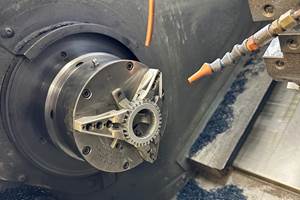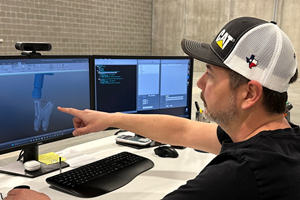Metal Additive Manufacturing: Multitasking’s Latest Trend
Why are an increasing number of machine tool builders adding additive manufacturing to their equipment’s already versatile machining capabilities? Because additive and subtractive are complementary.
Share





Additive manufacturing, technology that builds 3D components layer-by-layer, continues to evolve. Once a tool primarily used for prototyping parts in plastics, it is starting to impact the manufacturing design and production world in a more significant way with the advent of metal parts printing. In short, this technique offers advantages in that it can produce complex, contoured designs that would be challenging if not impossible to create on conventional machining equipment (such as conformal cooling channels inside injection molds). Part designs also can be refined for reduced weight while retaining (or enhancing) structural integrity by applying concepts such as generative design.
That said, AM is a technology that complements machining, but won’t replace it. Interestingly enough, there’s no clearer way to punctuate this point than to look to the increasing number of machine tool builders adding additive to their subtractive equipment platforms.
Virtually all AM-built parts need some sort of post-processing operations. This might entail milling, drilling, tapping or turning as well as grinding or polishing. By combining additive and subtractive on one platform, work-in-process can be eliminated as well as the capital equipment required to complete an additively grown part. Plus, AM can be used to add small, complex features to large, machined parts. Or, for repair work, material can be added to worn parts that could then be machined away to bring them back to OEM specifications.
AM processes such as laser cladding have been added to various machining platforms, including turn-mills and five-axis machines. The video below shows an example of the former: a WFL M80X Millturn in which the laser head installs into the B-axis milling spindle to add material to a very large component. Laser hardening of select features can be performed, too.
In this case of this Mazak Integrex i-400S AM using additive to add features to a long feedscrew component, the AM laser deposition head (three are available having varying beam diameters with this model) is not mounted in the machine’s B-axis milling spindle. Instead, it installs in a dedicated, pivoting unit, and unused laser heads are stored outside the workzone much like tools would be in a machining center’s automatic toolchanger carousel.
The next video shows an example of repair work. Here, a five-axis Tong Tai AMH-630 uses an AM laser cladding head that fits into the machine’s milling spindle to deposit Inconel 718 material onto the worn tips of turbine blades that is then subsequently machined, leaving behind the OEM-specified contoured shapes.
But, there might also be need to print a part and machine to completion on the same machine. In the following example, a part is printed to near-net-shape on a five-axis DMG MORI Lasertec 125 3D hybrid and then finish-machined.
Software for these hybrid applications continues to evolve, too, just as the hardware does. This video shows the production of an Inconel 625 blisk using Autodesk Fusion 360 and PowerMill software on a Mazak Variaxis J-600/5XAM hybrid machine using Seco Tools’ solid carbide and ceramic tools. Rather than starting with a large billet of material that will be machined away to create the blisk, the workpiece starts with the hub and the blades are then additively grown and machined to shape and size.
Still, how do you program a multitasking machine with additive capability? This lengthy but informative video takes you step-by-step through the programming process for a rotary part with blades created via AM and then subsequently finish-machined using Siemens NX CAM.
And what about offline simulation that is so important to complex machining work? CGTech’s Vericut additive module simulates both additive and traditional machining (milling or turning) capabilities of hybrid machines using the same NC code. It reads the laser parameters, controls laser wattage, flow of carrier gas, and metallic powder specific to each job and material type, then detects possible collisions between the machine and additive part as it is being printed as is described in this video.
Of course, there is the opportunity to add AM heads to various other types of machine platforms. For instance, 3D Hybrid Solutions can supply add-on heads for metal 3D printing via various methods of deposition, including laser melting of powder spray, arc melting of wire feed and high-velocity cold spray of metal powder. It seems this idea has the approval of the U.S. Marines as explained here.
Related Content
Chuck Jaws Achieve 77% Weight Reduction Through 3D Printing
Alpha Precision Group (APG) has developed an innovative workholding design for faster spindle speeds through sinter-based additive manufacturing.
Read MoreDigital Transparency in Machining Key to Multi-Site Additive Manufacturing
Cumberland Additive’s CNC programmer in Pennsylvania spends most of his time writing programs for machine tools in Texas.
Read MorePush-Button DED System Aims for Machine Shop Workflow in Metal Additive Manufacturing
Meltio M600 metal 3D printer employs probing, quick-change workholding and wire material stock to permit production in coordination with CNC machines.
Read MoreMachine Tool Drawbar Made With Additive Manufacturing Saves DMG MORI 90% Lead Time and 67% CO2 Emission
A new production process for the multimetal drawbar replaces an outsourced plating step with directed energy deposition, performing this DED along with roughing, finishing and grinding on a single machine.
Read MoreRead Next
How I Made It: Dennis Rymanowski
Dennis Rymanowski has worked at NSH USA for 60 years, with his passion for manufacturing living alongside his passion for his family’s polka band.
Read MoreA New Frontier in Surface Finish Control
What if your machine tool could measure surface roughness as it cuts? This article explores how in-process metrology is advancing from concept to reality, enabling real-time feedback, immediate detection of anomalies and new levels of control over surface quality. Discover the technologies making this possible.
Read More






















